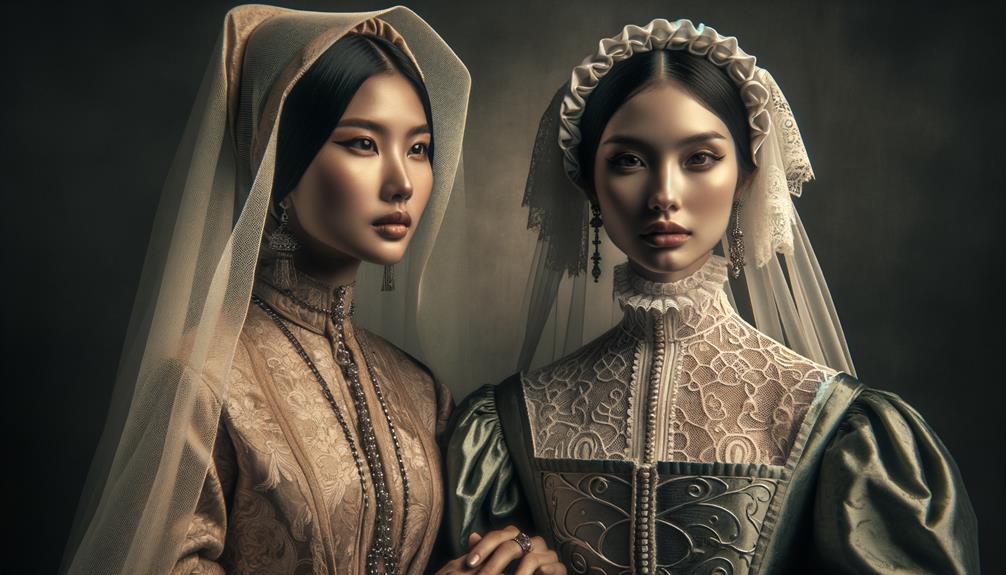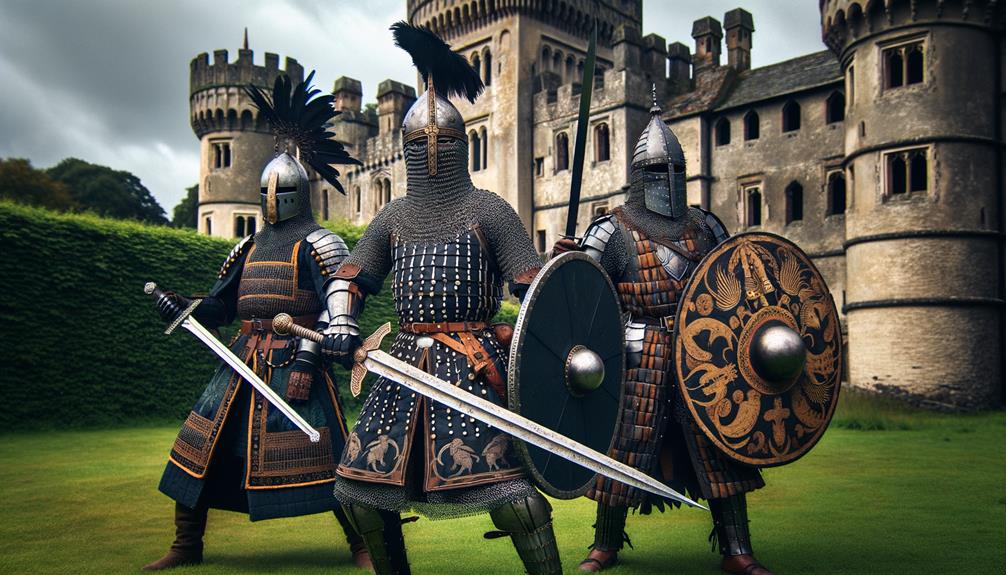I'm fascinated by how the Crusades reshaped European fashion. With the influx of Eastern textiles, silk became more accessible, sparking creativity and leading to garments like the bliaut, which merged styles from different worlds. Men's fashion became more vibrant and complex, while women's attire evolved into structured elegance. These cultural exchanges went beyond trade; they transformed the fabric of society. What intrigues me is how these changes reflect a deeper shift in European identity. How did these influences persist and shape what we wear today?
Trade and Fabric Influx
How did the Crusades transform European fashion through the influx of exotic fabrics? I've often wondered how Islamic luxury permeated European wardrobes. The Crusades established trade routes, connecting the West to the East. Silk, once rare, began flowing into Europe through bustling ports like Acre, Alexandria, and Damietta.
Italian cities like Venice, Genoa, and Florence became hubs for this exchange. They imported luxurious textiles, turning them into fashion statements of the Middle Ages. It wasn't just about commerce; it was a cultural exchange. Islamic silk brocades, rich in texture and intricate in design, inspired European artisans.
These fabrics did more than just adorn; they inspired artistic expression. Madonna and Child paintings from the Crusader period often depicted figures draped in these Eastern textiles. The art reflected the evolving fashion, a sign of the influence of Islamic luxury. Through the trade routes, Europe's sartorial landscape transformed, embracing the opulence of the East.
In the end, the Crusades weren't solely about conquest. They facilitated connection, weaving together cultures that forever altered European fashion. Exotic fabrics became the threads of a new narrative, one of elegance and innovation.
Evolution of Garments
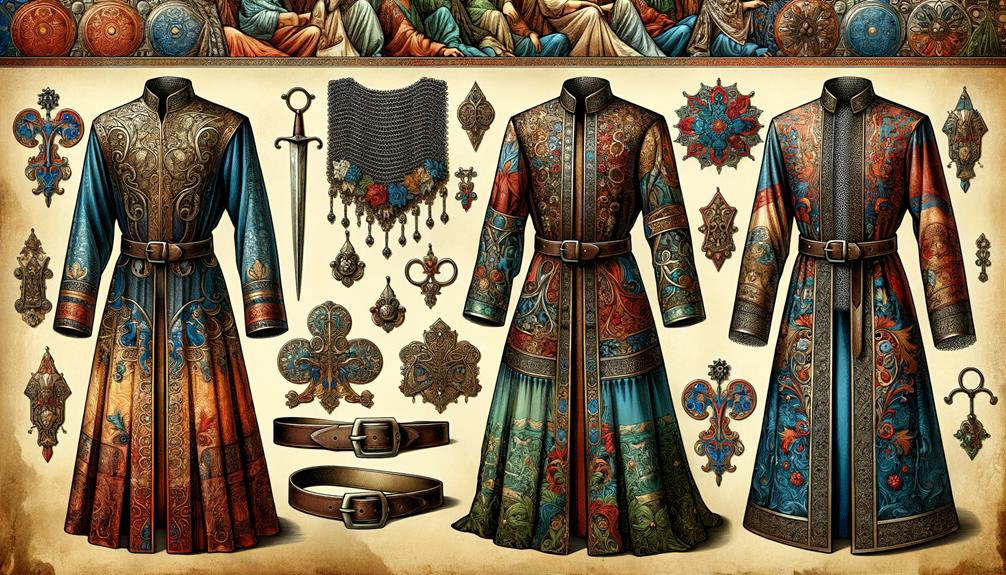
The influx of Eastern fabrics into Europe sparked a radical transformation in garment structure and style. The bliaut, with its long tunics and tight sleeves, became a symbol of this change, directly influenced by the exotic textiles brought back by European knights. These garments weren't just clothing; they were symbols of cultural exchange, status, and honor.
The Crusades, initiated by Pope Urban II, led knights to the Holy Land, where they discovered new fabrics, patterns, and textiles. Upon their return, they brought back silks, brocades, and patterns that were previously unseen in Europe. This influx of new materials didn't just influence the upper echelons of society; it filtered down, changing how everyone dressed.
| Era | Fashion | Influence |
|---|---|---|
| Pre-Crusades | Simple tunics | Local materials |
| Early Crusades | Bliauts | Eastern textiles |
| Middle Crusades | Layered garments | Islamic patterns |
| Late Crusades | Embroidered robes | Cultural exchange |
| Post-Crusades | Liturgical use | Crusader states' prosperity |
The trade routes established through Crusader states like Acre and Antioch facilitated this surge in luxury goods. Textiles became intertwined with identity, reflecting the profound shifts initiated by Pope Urban II and the ongoing cultural exchange.
Influences on Men's Fashion
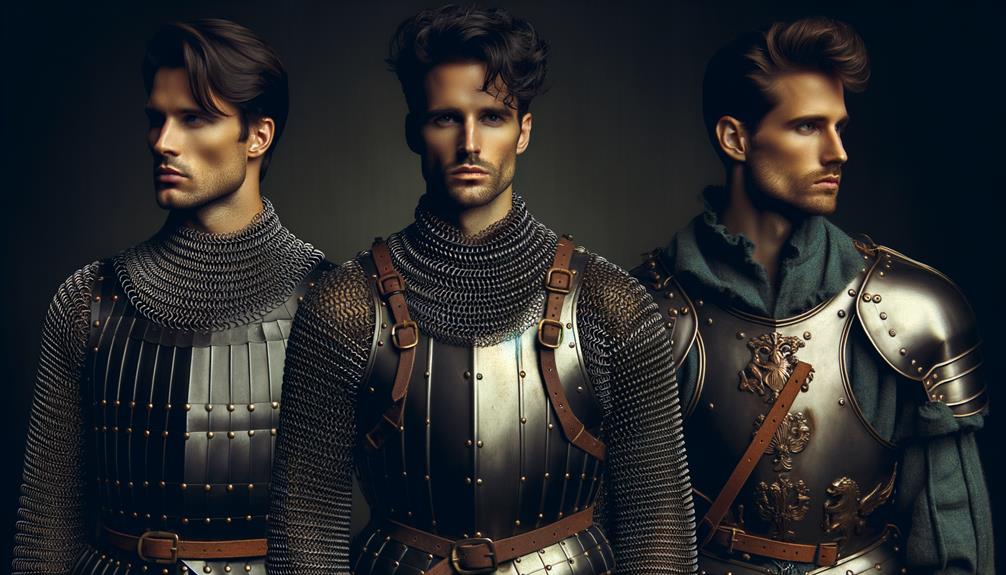
During the Crusades, men's fashion underwent a significant transformation, blending Roman, Byzantine, and exotic Eastern influences into a unique and sophisticated style. Luxurious fabrics from Fatimid Egypt flooded Western Europe, introducing vibrant colors and intricate patterns that elevated aristocrats' wardrobes.
The bliaut, once a moderately fitted garment, evolved into a tightly tailored piece, reflecting a desire for elegance and precision. Tunics, often adorned with Arabic script, became statements of cultural fusion, showcasing the influence of international encounters. These garments were more than just clothing; they symbolized status and exposure to distant lands.
Headwear also saw innovation, with men donning turbans and caps inspired by Eastern designs, a nod to their international experiences. Intricately decorated belts from the East cinched their garments, combining functionality with ornamentation.
Hose and underclothes adapted as well, with softer, finer materials replacing coarse fabrics from earlier times. The Crusades not only changed the battlefield but also reshaped Western European fashion, weaving together a tapestry of global influences that redefined men's lives in both practical and aesthetically profound ways.
Influences on Women's Fashion
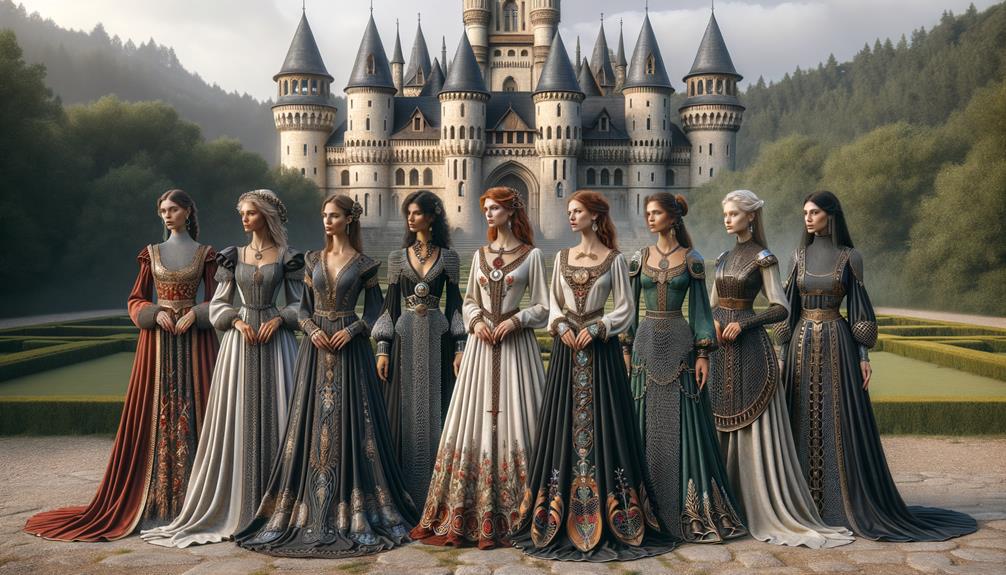
During the Crusades, women's fashion underwent a remarkable transformation, incorporating exotic influences to create elegant and structured attire. The bliaut, characterized by full skirts and tight sleeves, became a staple of the era. These garments, often laced at the sides, showcased the meticulous artistry of the period.
Three key elements redefined women's fashion during this time:
- Structured Silhouettes: Belts and cinctures emphasized the waist, introducing a new level of sophistication to women's attire.
- Veils and Wimples: These accessories served not only for modesty but also as symbols of grace and elegance.
- Intricate Hairstyles: Braids and updos became statements of fashion, reflecting the era's cultural tapestry.
These elements weren't just fashion choices; they reflected the era's cultural landscape. The robes of honor, inspired by those worn by Muslim armies, influenced the grandeur and opulence of women's garments. This cross-pollination of styles enriched the aesthetic, blending Eastern and Western influences.
Interestingly, even working-class women adopted elements of this elevated style, albeit in simpler forms. In contrast, courtly women reveled in luxurious fabrics and elaborate designs, highlighting the social divide of the era. This period was more than a historical moment; it was a fashion revolution that left a lasting impact on women's attire.
Cross-Cultural Exchanges
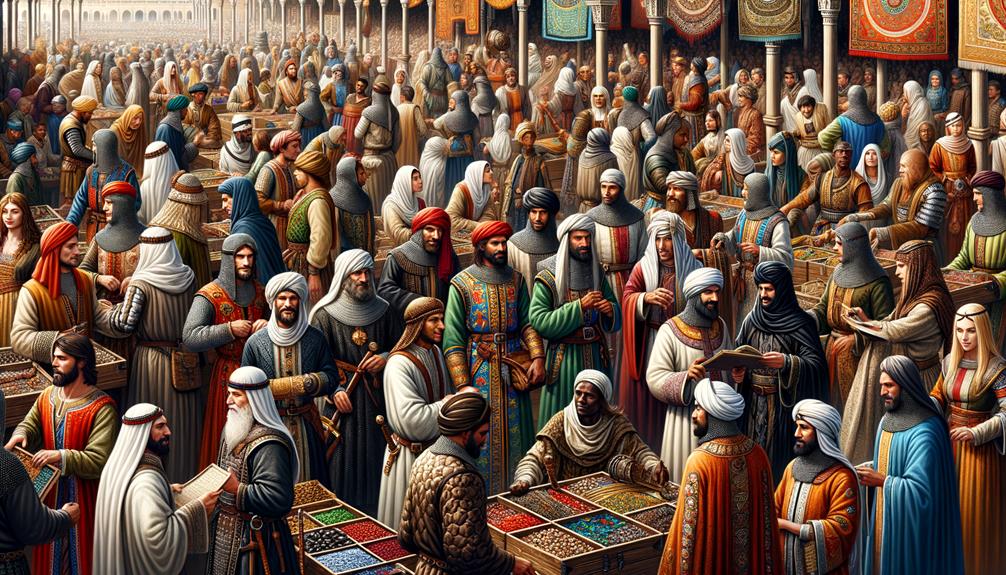
The Crusades carved out a rich tapestry of cultural exchange between East and West. I envision the Italian merchant cities – Amalfi, Genoa, Venice, Florence – bustling with activity, their docks alive with goods. Ports like Latakia, Tripoli, Acre, Alexandria, and Damietta became the hubs of this exchange, pulsing with life.
The intricate patterns and vibrant colors of Islamic silk weaving caught the eye of Europeans. These fabrics weren't just materials; they told stories, woven with threads of history. I imagine the Madonna and Child paintings of the period, their robes draped in luxurious brocades, echoing the influence of Islamic craftsmanship. The subtle sheen of silk, the detailed embroidery – each painting reflected this cross-cultural dialogue.
Glassware from Syria mirrored this exchange. European artisans absorbed these techniques, blending them into their own traditions. The result was a fusion, a blend of East and West that went beyond mere trade. It was innovation born from curiosity and necessity.
In these exchanges, I see the foundation of modern fashion's global dialogue. Each piece, each technique, a fragment of a larger, intricate mosaic that continues to evolve.
Lasting Fashion Legacies
The Crusades not only shaped trade, but they also left an indelible mark on European fashion. Every time I visit an art museum, I'm reminded of how textiles and clothing styles from North Africa and the Middle East influenced Western attire. What fascinates me is how these influences have persisted and evolved over time.
Three lasting legacies stand out:
- Textile Innovation: The Crusades introduced intricate Islamic textiles to European markets, revolutionizing aristocratic wardrobes with vibrant fabrics and intricate patterns.
- Symbolic Status: These exotic fabrics soon became symbols of honor and status, even adorning Christian liturgical garments, conveying prestige and power.
- Cultural Fusion: The blending of Islamic and Christian motifs in fashion fostered a unique cross-cultural aesthetic, reflecting the rich cultural exchange between the two worlds.
As I walk through galleries, I can trace the threads of these legacies. The rich brocades and silks from the Islamic world merged with European designs, creating something entirely new and breathtaking. It's a testament to the enduring dialogue between Islam and Christianity, a conversation that continues to shape our cultural landscape. The Crusades may be history, but their influence on fashion remains timeless, a vivid reminder of how cultures can intersect in unexpected and beautiful ways.
Frequently Asked Questions
What Clothes Did Crusaders Wear?
Crusaders wore practical clothing for battle and travel, combining European and Middle Eastern styles. They layered tunics, surcoats, and chainmail, with knights flaunting elaborate armor and foot soldiers wearing simpler gear. The garments often featured crosses, a symbol of their mission.
What Did the Crusades Influence?
The Crusades had a profound impact on European culture, sparking economic growth, introducing new ideas, art, and technology. Their influence can still be seen today, blending innovation with tradition, and leaving a lasting legacy of cross-cultural exchange.
What Influenced Medieval Fashion?
Medieval fashion was shaped by cultural exchanges, trade routes, and the return of Crusaders. The influx of luxurious fabrics and styles from the East had a profound impact on European wardrobes, blending practicality with newfound elegance.
What Goods Came From the Crusades?
The Crusades brought exotic goods to Europe, transforming our markets. I saw silk, spices, sugar cane, and brocade become staples. Islamic artistry influenced our metalwork and glassware, while new culinary delights like pasta and rice amazed us.



